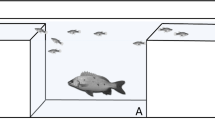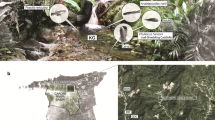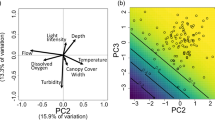Abstract
The addition of nocturnal, Hoplias malabaricus, and diurnal, Crenicichla alta, predatory fishes downstream of barrier waterfalls increases predation threat for a killifish, Rivulus hartii, in Trinidadian streams. We hypothesized that the diel patterning of predation risk would affect prey movement rates, and tested this hypothesis by comparing movement in river sites/zones containing both the nocturnal and diurnal predator with movement in river sites/zones containing only the nocturnal taxon. We evaluated this prediction in the framework of an intermediate threat hypothesis (ITH) that holds that movement will be highest at some intermediate level of threat. We marked prey fish in study sites in two watersheds of a river, each with waterfalls that divided the river into three zones: a predator absent zone (P0), a zone with one nocturnal predator (P1), and a zone with one nocturnal and one diurnal predator (P2), and tested the ITH prediction that movement will be ordered as P0<P1>P2. The single predator promoted longitudinal movement by Rivulus (P0<P1), while zones with the two predators retarded movement for small Rivulus (P1>P2) as predicted by the ITH. However, movement by larger, less vulnerable Rivulus remained elevated (P1=P2 or P2>P1). A displacement experiment in each zone found that threat tended to reduce the probability of a displaced fish reaching home, but the two predator zones did not differ from one another in their effect on this probability. Hence, the prediction that predator activity over the full 24 h diel cycle would retard movement, P2<P1, was not supported with respect to homing. Because habitat and predator communities change predictably from headwater streams to larger rivers in many lotic ecosystems, we present a conceptual model for predicting fish movement behavior along this continuum. The model posits an important role for predation threat, and the size and spacing of refuge patches, suggesting that human alterations of these factors will affect the natural movement of fish in streams.
Similar content being viewed by others
References
Albanese B, Angermeier PL, Gowan C (2003) Designing mark-recapture studies to reduce effects of distance weighting on movement distance distributions of stream fishes. Trans Am Fish Soc 132:925–939
Albanese B, Angermeier PL, Dorai-Raj S (2004) Ecological correlates of fish movement in a network of Virginia streams. Can J Fish Aquat Sciences 61:857–869
Angermeier PL, Winston MR (1998) Local vs. regional influences on local diversity in stream fish communities of Virginia. Ecology 79:911–927
Brown JS (1999) Vigilance, patch use, and habitat selection: foraging under predation risk. Evol Ecol Res 1:49–71
Culp JM, Scrimgeour GJ (1993) Size-dependent diel foraging periodicity of a mayfly grazer in streams with and without fish. Oikos 68:242–250
Doncaster CP, Clobert J, Doligez B, Gustafsson L, Danchin E (1997) Balanced dispersal between spatially varying local environments: an alternative to the source-sink model. Am Nat 150:424–445
Endler JA (1987) Predation, light intensity, and courtship behaviour in Poecilia reticulata. Anim Behav 35:1376–1385
Fraser DF, Gilliam JF (1992) Nonlethal impacts of predator invasion: facultative suppression of growth and reproduction. Ecology 73:959–970
Fraser DF, Gilliam JF, Yip-Hoi T (1995) Predation as an agent of population fragmentation in a tropical watershed. Ecology 76:1461–1472
Fraser DF, Gilliam JF, MacGowan MP, Arcaro CM, Guillozet PH (1999) Habitat quality in a hostile river corridor. Ecology 80:597–607
Fraser DF, Gilliam JF, Daley MT, Le AN, Skalski GT (2001) Explaining leptokurtic movement distributions: intrapopulation variation in boldness and exploration. Am Nat 158:124–135
Gilliam JF, Fraser DF (2001) Movement in corridors: enhancement by predation threat, disturbance, and habitat structure. Ecology 82:258–273
Gonzalez MJ, Tessier AJ (1997) Habitat segregation and interactive effects of multiple predators on a prey assemblage. Freshwater Biol 38:179–191
Gorman OT (1986) Assemblage organization of stream fishes: the effect of rivers on adventitious streams. Am Nat 128:611–616
Harvey BC, White JL, Nakamoto RJ (2004) An emergent multiple predator effect may enhance biotic resistance in a stream fish assemblage. Ecology 85:127–133
Johansson J, Turesson H, Persson A (2004) Active selection for large guppies, Poecilia reticulata, by the pike cichlid, Crenicichla saxatilis. Oikos 105:595–605
Kotler BP, Blaustein L, Brown JS (1992) Predator facilitation: the combined effect of snakes and owls on the foraging behavior of gerbils. Ann Zoologici Fennici 29:199–206
Lampert W (1993) Ultimate causes of diel vertical migration of zooplankton: new evidence for the predator-avoidance hypothesis. Archiv fur Hydrobiologie Ergebnisse der Limnologie 39:79–88
Leopold LB, Wolman MG, Miller JP (1964) Fluvial processes in geomorphology. W.H. Freeman and Company, San Francisco, U.S.A
Lima SL, Dill LM (1990) Behavioral decisions made under the risk of predation: a review and prospectus. Can J Zool 68:619–640
Lima SL, Bednekoff PA (1999) Temporal variation in danger drives antipredator behavior: the predation risk allocation hypothesis. Am Nat 153:649–659
Lonzarich DG, Lonzarich MR, Warren ML Jr (2000) Effects of riffle length on the short-term movement of fishes␣among stream pools. Can J Fish Aquat Sci 57: 1508–1514
Magnhagen C (1991) Predation risk as a cost of reproduction. Trends Ecol Evol 6:183–185
Matthews WJ (1998) Patterns in freshwater fish biology. Chapman & Hall, New York, USA
McCullagh P, Nelder JA (1989) Generalized linear models. Chapman & Hall, London, UK
Paul MJ, Meyer JL (2001) Streams in the urban landscape. Ann Rev Ecol Syst 32:333–365
Rahel FJ (2002) Homogenization of freshwater faunas. Ann Rev Ecol Syst 33:291–315
Reebs SG (2002) Plasticity of diel and circadian activity rhythms in fishes. Rev Fish Biol Fish 12:349–371
Schaefer J (2001) Riffles as barriers to interpool movement by three cyprinids (Notropis boops, Campostoma anomalum, and Cyprinella venusta). Freshwater Biol 46:379–388
Schlosser IJ (1990) Environmental variation, life history attributes, and community structure in stream fishes: implications for environmental management and assessment. Environ Manage 14:621–628
Schultz CB (1998) Dispersal behavior and its implications for reserve design in a rare Oregon butterfly. Conserv Biol 12:284–292
Schultz CB (2001) Edge-mediated dispersal behavior in a prairie butterfly. Ecology 82:1879–1892
Sih A, Englund G, Wooster D (1998) Emergent impacts of multiple predators on prey. Trends Ecol Evol 13:350–355
Sih A, Ziemba R, Harding KC (2000) New insights on how temporal variation in predation risk shapes prey behavior. Trends Evol Ecol 15:3–4
Vance-Chalcraft HD, Soluk DA, Ozburn N (2004) Is prey predation risk influenced more by increasing predator density or predator species richness in stream enclosures? Oecologia 139:117–122
Vandermeer J, Carvajal R (2001) Metapopulation dynamics and the quality of the matrix. Am Nat 158:211–220
Winemiller KO (1989) Ontogenetic diet shifts and resource partitioning among piscivorous fishes in the Venezuelan ilanos. Environ Biol Fishes 26:177–199
Winemiller KO (1990). Spatial and temporal variation in tropical fish trophic networks. Ecol monogr 60:331–337
Winer BJ (1991) Statistical principles in experimental design. 3rd edn. McGraw-Hill Book Company
Woodward G, Hildrew AG (2002) Body-size determinants of niche overlap and intraguild predation within a complex food web. J Anim Ecol 71:1063–1074
Acknowledgements
We thank the late Roopchard (Boysie) Ramdeen of Verdant Vale for the use of Ramdeen Stream, the Asa Wright Nature Center (Simla and manager Ronnie Hernandez), and Dr. Mary Alkins-Koo for logistical support. We thank our stalwart Trinidadian field workers Ephriam Farfan, and Jose and Ramon Rodriguez and additional field workers, Ryan Baisley, Brian Baksh, Asbert Cuffy, Carl Fitzjames, Dan Nuckles, Jared Lendrum, Kelly Malchan, Jacob Miano, Jennifer Peloquin, Brandon Puckett, Wayne Rostant, John Saathoff, Chip Small, and Lauren Sokolik, and Sundar Dorai-Raj for statistical advice. The study was supported by the National Science Foundation.
Author information
Authors and Affiliations
Corresponding author
Rights and permissions
About this article
Cite this article
Fraser, D.F., Gilliam, J.F., Albanese, B.W. et al. Effects of temporal patterning of predation threat on movement of a stream fish: evaluating an intermediate threat hypothesis. Environ Biol Fish 76, 25–35 (2006). https://doi.org/10.1007/s10641-006-9004-9
Received:
Accepted:
Published:
Issue Date:
DOI: https://doi.org/10.1007/s10641-006-9004-9




